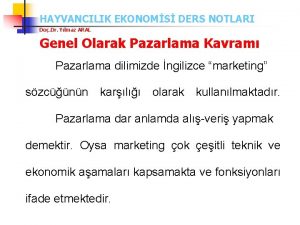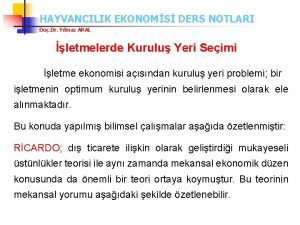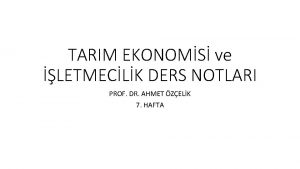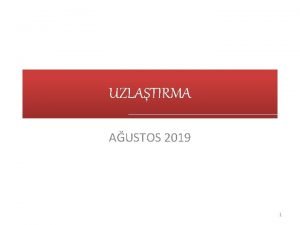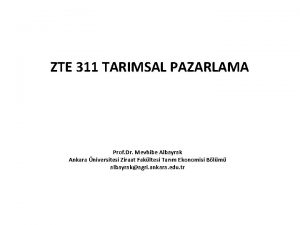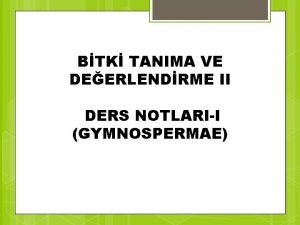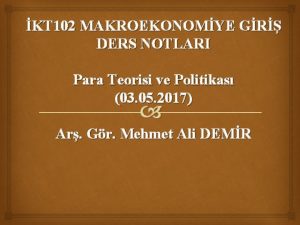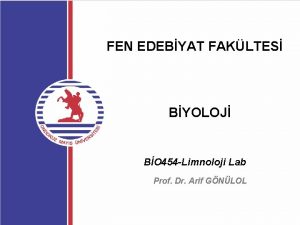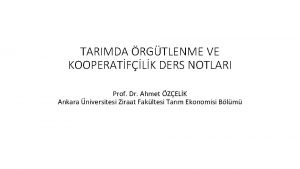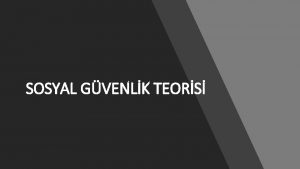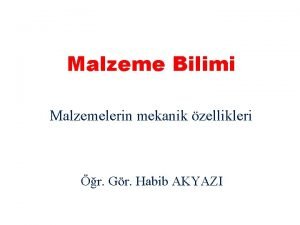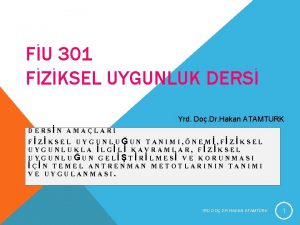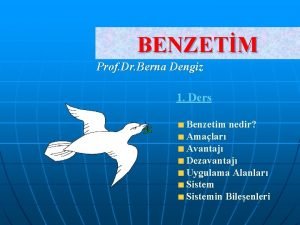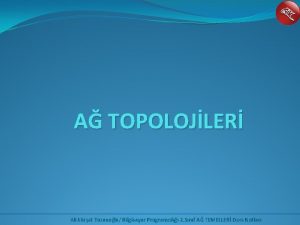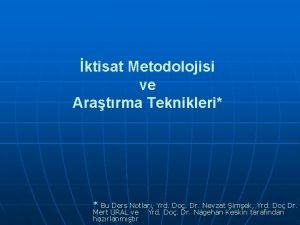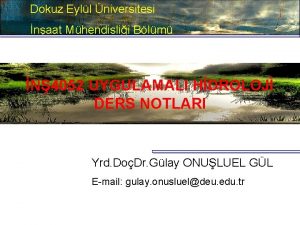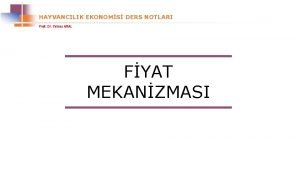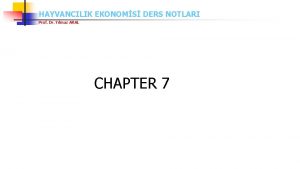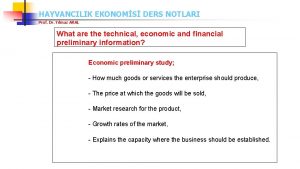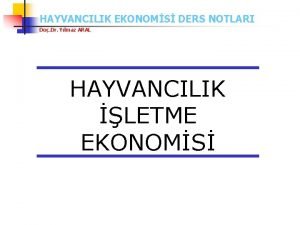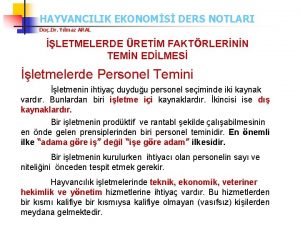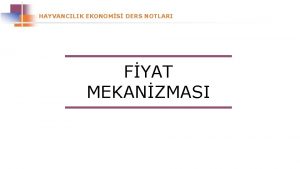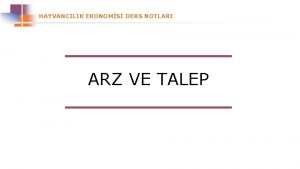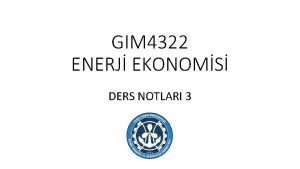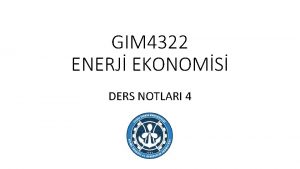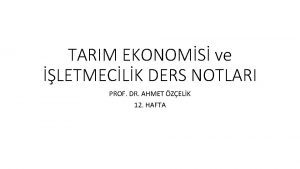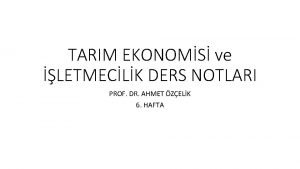HAYVANCILIK EKONOMS DERS NOTLARI Prof Dr Ylmaz ARAL

















- Slides: 17

HAYVANCILIK EKONOMİSİ DERS NOTLARI Prof. Dr. Yılmaz ARAL SUPPLY AND DEMAND

HAYVANCILIK EKONOMİSİ DERS NOTLARI Prof. Dr. Yılmaz ARAL In the economy of change, ie in the money-based economy, everyone is obliged to produce for the needs of others as well as their own needs and to provide the goods in need for a price. This necessity leads to the emergence of demand. People will also want to sell their goods and services or production factor to the market for a price in order to purchase some goods and services they need. This, in turn, reveals the presentation in the economy, in other words, the supply. Price regulates the problem of which goods will be produced, how and for whom, and at the same time the optimum use of resources in an economy in which the market mechanism applies. The price of a particular good in a given market, at a given time, depends on the demand supply of that good.

HAYVANCILIK EKONOMİSİ DERS NOTLARI Prof. Dr. Yılmaz ARAL SUPPLY

HAYVANCILIK EKONOMİSİ DERS NOTLARI Prof. Dr. Yılmaz ARAL Supply concept Supply is the willingness and willingness of producers to sell the economic goods and services they hold in a given market, at a given time, at a certain price. Production and supply are not the same. The main differences between supply and production can be explained as follows. The amount of supply is generally smaller than current production. Occasionally, there are cases where current production is smaller than supply. The difference is caused by imports. One of the reasons why current production is different (greater) than current supply is the stocking of a certain portion of economic goods.

HAYVANCILIK EKONOMİSİ DERS NOTLARI Prof. Dr. Yılmaz ARAL The purpose of stocking is within two-way. The first objective is to ensure continuity in the supply of economic goods, to prevent significant fluctuations in supply and to prevent price decreases. The second aim is to create speculation. This type of stocking is to get in the period, when the product is abundant and cheap and to sell when the product is expensive and scarce in the period The second important difference between supply and production is that the producers themselves are consumers. The third difference between supply and production is due to technological deficiencies in the marketing system. Even if some products are set out for sale for supply, they cannot reach the sales stage. For example, products such as meat, milk, vegetables and fish can perish quickly. The inadequacy of the cold storage chain and capacity causes large amounts of deterioration and waste formation during transport.

HAYVANCILIK EKONOMİSİ DERS NOTLARI Prof. Dr. Yılmaz ARAL Supply can be defined as the quantity of goods and services offered for sale in a given period. Supply at a certain price is the amount that the owners of a commodity would want to sell at that price. For example, when the price of the meat is 20 TL/kg and the meat supply is 60 tons, it is mean; quantity supplied at a certain price. There is a similar relationship between the price of a good and the quantity of supply. The supply shedule refers to the quantities that a product is intended to be sold against different prices, in other words, it means the general character of the supply of that product and the functional relationships between prices and supply quantities. The supply curve of a good can be drawn with the help of the supply shedule of that good. This curve shows the functional relationships between prices and supply quantities and moves from left to right. In the supply curve, the relationship between prices and quantities is in same direction.

HAYVANCILIK EKONOMİSİ DERS NOTLARI Prof. Dr. Yılmaz ARAL Table 3. Supply Schedule Amount Supplied (Tons) 200 10 250 20 325 30 500 40 400 800 50 300 Price (x 1000 TL) Price of Good (TL) 900 800 700 600 500 200 10 20 30 40 50 Amount (tons)

HAYVANCILIK EKONOMİSİ DERS NOTLARI Prof. Dr. Yılmaz ARAL Factors affecting supply Price of goods : The higher the price of the good, the more profitable it can be. Therefore, as the price increases, the quantity supplied increases; when the price decreases, the quantity of goods supplied decrease. Prices of other goods: If the price of a good remains the same, and the price of other goods increases, the production and supply of those goods becomes more attractive. Prices of production factors: Since the decrease in the prices of the factors of production used in the production of an economic good or service will reduce the cost of production of the good or service, the amount of profit to be obtained from the sales price in the market will be higher. This will increase the production and thus the supply of the goods. Changes in production technology: Technological advances will increase the productivity of production factors, particularly labor, which will result in a cost reduction; low cost means more profit.

HAYVANCILIK EKONOMİSİ DERS NOTLARI Prof. Dr. Yılmaz ARAL Supply Shift (Change) It is important not to confuse the situation where the supply quantity of an economic good increases and decreases, the supply curve shifts completely to the right or left. Price (x 1000 TL) The change in the quantity of supply is the transition from one point to another on a given supply curve. On the other hand, the shift of the supply curve to the right means that the quantity supplied from each price has increased compared to the previous supply curve. 900 C 800 700 600 500 400 300 200 A B 100 10 20 30 40 50 Amount (tons)

HAYVANCILIK EKONOMİSİ DERS NOTLARI Price (x 1000 TL) Prof. Dr. Yılmaz ARAL 900 800 700 600 500 400 300 200 10 20 30 40 50 Amount (tons) SUPPLY SHIFT (CHANGE)

HAYVANCILIK EKONOMİSİ DERS NOTLARI Price (x 1000 TL) Prof. Dr. Yılmaz ARAL 900 800 700 600 500 400 300 200 10 20 30 19 30 40 50 Amount (tons) 42

HAYVANCILIK EKONOMİSİ DERS NOTLARI Prof. Dr. Yılmaz ARAL Supply Flexibility The change in quantity offered in response to the changes in the prices of an economic good or service is explained by supply flexibility. There are several variables that affect the quantity of goods supplied. One of these variables is the supply flexibility of the concept which only reveals the sensitivity of supply in the case of price changes. Here the changes are evaluated proportionally, not absolute value. It is possible to formulate this definition as follows. Supply Flexibility = Proportional change in the amount of supply Proportional change in price ( ( ) ) Supply 2 – Supply 1 Supply Flexibility = Supply 1 Price 2 – Price 1 X 100

HAYVANCILIK EKONOMİSİ DERS NOTLARI Prof. Dr. Yılmaz ARAL Example: The wholesale price of one kg of lamb in a market is 10 TL. Producers supply 400 tons of meat to the market at this price. When the price of carcass lamb meat increased to TL 14. 00 for various reasons, it was observed that the producers increased their meat supply to 440 tons. Accordingly, what is the supply flexibility of lamb in the Ankara market? Supply 1 = 400 tons Price 1 = 10 TL Supply 2 = 440 tons Price 2 = 14 TL ( ( ) ) Supply 2 – Supply 1 Supply Flexibility= Supply 1 Price 2 – Price 1 SF= X 100 Price 1 440 -400 14 – 10 10 X 100 10 = 0, 25 = 40

HAYVANCILIK EKONOMİSİ DERS NOTLARI Prof. Dr. Yılmaz ARAL The value obtained as a result of the flexibility calculations is evaluated with reference to the value of 1. If the flexibility value found is equal to 1, the unit flexibility definition is defined for the supply of the goods in question. Accordingly, the amount of supply change is equal to the change in price. If greater than 1; The supply is flexible. In other words, the amount of supply varies at a higher rate than the change in price. If it is less than 1; The supply is not flexible. In other words, the amount of supply varies at a lower rate than the change in price. The supply flexibility coefficient is positive. Because the relationship between price and quantity of supply is positive. To interpret the result found as 0. 25; Sf = 0, 25 < 1 ; that is, the supply flexibility of lamb is less than 1. The amount of lamb supplied to the market is not very sensitive to price changes.

If the supply flexibility is infinite, the curve runs parallel to the quantity axis. In other words, it means infinite amount of goods flowing to the market at a certain price. If the supply flexibility is at unit flexibility, ie Ae = 1, the supply curve is a line that passes through the origin.

HAYVANCILIK EKONOMİSİ DERS NOTLARI Prof. Dr. Yılmaz ARAL Factors affecting supply flexibility are: The effect of increasing production on costs; Whether the production technique is suitable for making adjustments in the supply; Whether the economic good is suitable for waiting conditions. Generally in animal products, in the short term, the flexibility of supply is less than 1.

HAYVANCILIK EKONOMİSİ DERS NOTLARI Prof. Dr. Yılmaz ARAL Any Questions? !?
 Hayvancılık ekonomisi ders notları
Hayvancılık ekonomisi ders notları Dinamik ders notları
Dinamik ders notları Ekonoms
Ekonoms Santrifüjleme
Santrifüjleme Uzlaşma edimi yerine getirilmezse
Uzlaşma edimi yerine getirilmezse Tarımsal pazarlama ders notları
Tarımsal pazarlama ders notları Gymnospermae ders notları
Gymnospermae ders notları Para teorisi ders notları
Para teorisi ders notları Limnoloji ders notları
Limnoloji ders notları Kooperatifçilik ders notları
Kooperatifçilik ders notları Sabit oranlar kanunu
Sabit oranlar kanunu Sosyal güvenlik teorisi ders notları
Sosyal güvenlik teorisi ders notları Malzeme bilimi (ders notlari dokuz eylül)
Malzeme bilimi (ders notlari dokuz eylül) Fiziksel uygunluk ders notları
Fiziksel uygunluk ders notları Benzetim ders notları
Benzetim ders notları Ağ temelleri
Ağ temelleri Pozitivizm nedir
Pozitivizm nedir Hidroloji ders notlari
Hidroloji ders notlari
